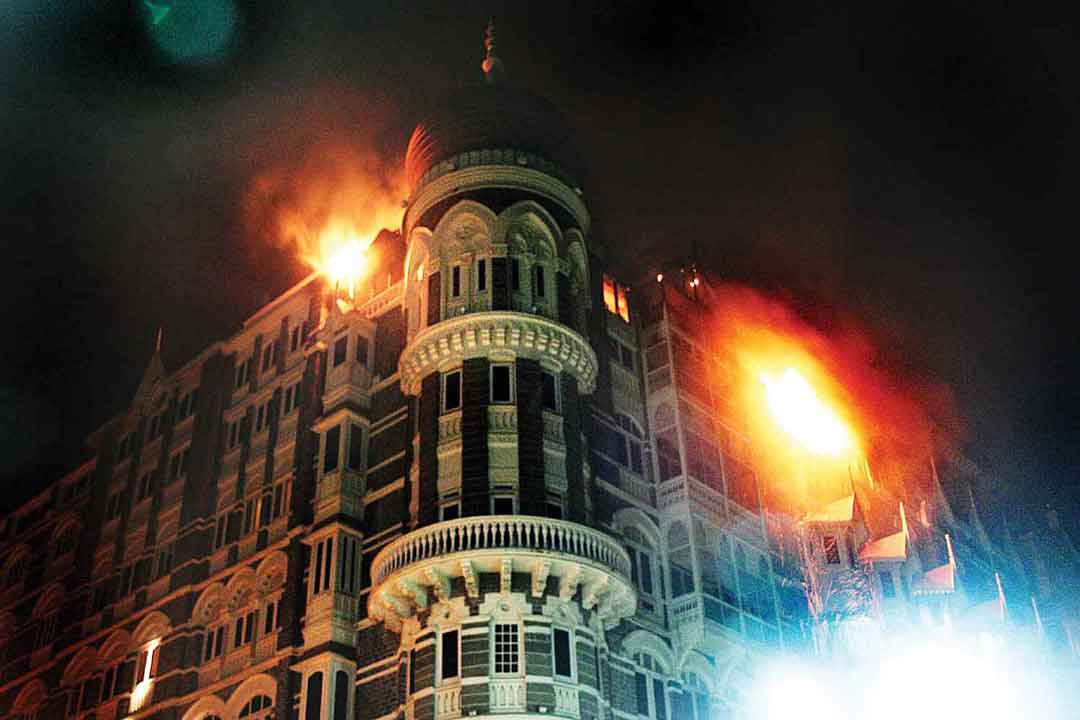
The heritage wing of the Taj Mahal Palace and Tower aflame, November 26. The Mumbai Fire Brigade evacuated hotel guests trapped inside. (Photograph: Uttam Ghosh/rediff.com)
The 2008 Mumbai attacks appear to have been a joint operation between two factions of the Lashkar that had been drifting apart due to policy disagreements. One was a ‘loyalist’ faction led by Sajid Mir; the other was a ‘dissident’ faction led by an ex-Army officer named Abdur Rehman Hashim. The latter wanted to focus on fighting Western forces in Afghanistan and possibly, extending support to Taliban groups fighting the Pakistani state. Mir, on the other hand, was a house-trained jihadist who despite his global Salafi inclinations, was ultimately prepared to defer to the India-centric agenda of his controllers. Between them, the two Lashkar commanders agreed on an operation that would strike at Western interests within the operational framework already laid out by the Lashkar leadership. The Mumbai attacks, it was hoped, would reduce tensions within the group and unite its cadres through a common sense of purpose and accomplishment.
It has been argued that the 26/11 attacks represented the externalisation of domestic militancy within Pakistan, which had drastically escalated following the Lal Masjid crisis of July 2007. During those three days in November 2008, India faced the fallout of a radical movement which it had no role in creating but which it seems destined to continue suffering from due to its geography. The country lies adjacent to a region that has traditionally been a haven for militant religious groups since the colonial era. As Charles Allen chronicles in his book ‘God’s Terrorists’, the borderlands of present-day Pakistan have long been associated with Jihadism.1 Urbanised, genteel Indians are perhaps yet to realise how close they are to this cauldron of extremist violence. Their government, however, has no excuse for underestimating the threat.
Towards A Plan
Initially, the Mumbai 2008 terror attacks were only meant to hit a conference of IT professionals that would be held annually in the Taj Mahal Palace and Tower Hotel. The original attack plan did not envisage a suicidal or fidayeen strike.
According to Charles Allen, the borderlands of present-day Pakistan have long been associated with Jihadism…
The Lashkar-e-Toiba (LeT) at this point in time (early 2006) was just looking to replicate its shoot-and-scoot operation at the Indian Institute of Science in Bangalore carried out on December 28, 2005, by a lone gunman who killed one person before fleeing. Despite the distance between Bangalore and the international border, the gunman safely reached Pakistan within three days due to a network of logistics and support cells that the LeT had created in India over the years.2 Once in Pakistan, he bragged to the Lashkar recruits about the ease with which armed assaults could be carried out in urban India. Among his audience were those who were later on selected for the Mumbai attack. LeT switched to the fidayeen option at the very last moment, after expanding the attack plan and then realising that the gunmen may not have the option to escape from Mumbai.
Immediately after the Bangalore shooting, a Pakistani-American LeT operative named Daood Gilani was tasked to reconnoiter potential targets in India for similar strikes. To avoid arousing suspicion whilst applying for an Indian visa, Gilani legally changed his name to David Headley. Beginning September 2006, he made several trips to India, befriending locals and videotaping public buildings and strategic installations. He later told American and Indian investigators that funding for his trips was provided by a serving Inter Services Intelligence (ISI) officer named Major Iqbal. From his interrogation report, it appears that Headley was a dual-purpose intelligence asset, being jointly run by the ISI and the LeT.3 While the former used him to spy upon locations that were of military significance, the latter was more interested in tactical reconnaissance of soft targets. Interestingly, US court documents suggest that out of US $29,500 provided to Headley between July 2006 and July 2008, as funding for his reconnaissance trips to India, only $1,000 came from the LeT. The remainder was handed over directly by Major Iqbal.4

Ajmal Amir Kasab's blood-spattered shoes were left on the road at Chowpatty, after the police captured him following a shoot-out and a physical scuffle, November 26. Next to the shoes lies a spent bullet. (Photograph: Sanjay Sawant/rediff.com)
Headley’s handler within the LeT was a Pakistani national named Sajid Majeed, better known as Sajid Mir. Born in 1976, to a middle class Punjabi family in Lahore, Mir was unusual within the Lashkar in that he was an Arabised Jihadist. His family maintained business interests in Saudi Arabia and he had often travelled there during childhood. This meant that he had grown exposed to global jihadist debate that had projected the West and Israel as being permanently at war with Islam. For Mir, India was the most proximate enemy but not necessarily the most important one. He also wanted to build a name for himself in the international jihadist movement.5
In 2006, Mir had set upon attacking the annual IT conference at Mumbai’s Taj Hotel, seeing it as a way to bolster his own standing within Lashkar by attacking both Indians and Westerners with one stroke. Unlike most of his counterparts in the LeT organisation, he had no actual combat experience. An attack on Mumbai would therefore, be his coming-of-age party. His personal ambitions received a boost from events that unfolded in Pakistan and India during 2007 – 2008, which convinced the LeT leadership of the need to enlarge the Mumbai operation and strike at multiple targets.
Lal Masjid – A Silent Mutiny
In July 2007, commandos from the Pakistan Army’s Special Services Group stormed the Lal Masjid (Red Mosque) in Islamabad. Radical students based in the complex had long been attacking local businesses and creating a law and order problem in the city. After some Chinese women were abducted by these students, behind-the-scenes pressure from Beijing forced President Pervez Musharraf to order an army assault. In the resulting gunfight, several female students were killed, of whom a large percentage were the daughters of serving army personnel. In the already fraught political climate of Pakistan, the attack was perceived by many as an inexcusable act of repression by an unpopular regime.
It appears that Headley was a dual-purpose intelligence asset, being jointly run by the ISI and the LeT…
The Lal Masjid crisis is relevant to the Mumbai attacks because of its adverse impact on institutional cohesion within the Pakistani military. The deaths of soldiers’ relatives within the mosque grounds had created a groundswell of anger among the ranks. On September 13, 2007, an SSG officer carried out a suicide bombing at a military base, killing 19 of his colleagues.6 At around the same time, jihadist sympathisers in the military began providing intelligence support to Taliban factions that were attacking the Pakistani state. Incidentally, it was this militant-military nexus that UN investigators later suspected of helping to assassinate the pro-West Pakistani leader, Benazir Bhutto.7




